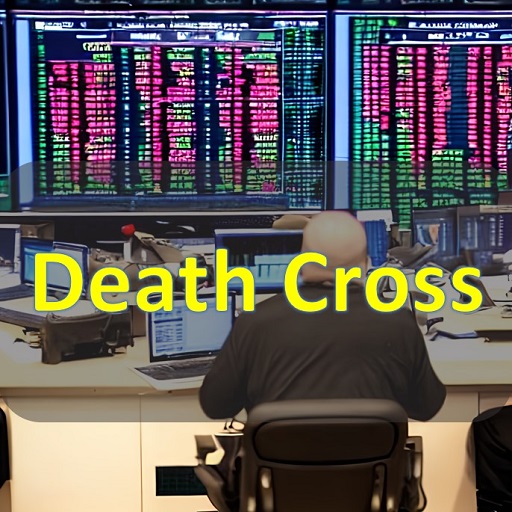In financial markets, a “death cross” refers to a technical chart pattern that occurs when the short-term moving average of an asset’s price falls below its long-term moving average. Specifically, it is a bearish signal that suggests a potential downward trend or further decline in the price of the asset.
The death cross is typically identified using two moving averages: the 50-day moving average and the 200-day moving average. When the 50-day moving average crosses below the 200-day moving average, it forms the death cross pattern. Traders and analysts pay attention to this pattern because it is believed to indicate a shift in market sentiment and a possible increase in selling pressure.
While the death cross can be seen as a warning sign, it is important to note that it is just one of many technical indicators used in financial analysis. Traders and investors often consider multiple factors and indicators before making decisions. It is always advisable to conduct thorough research and analysis before making any investment or trading choices.
Lagging indicator
The death cross is a lagging indicator, meaning that it confirms a trend that has already begun. It is not a predictive signal but rather a reflection of past price movements. As such, it may not always accurately forecast future price declines.
Different timeframes
The choice of moving average periods can vary depending on the trader’s preferences and the specific asset being analyzed. While the 50-day and 200-day moving averages are commonly used, other combinations, such as the 50-week and 200-week moving averages, can also be employed.
Context matters
It’s essential to consider the broader market context when interpreting the death cross. Other technical indicators, fundamental analysis, and market news should be taken into account to gain a more comprehensive understanding of the overall market conditions and potential price movements.
False signals
Like any technical analysis tool, the death cross is not foolproof and can sometimes generate false signals. It is possible for a death cross to occur but for the price to reverse and move higher instead of continuing downward. Traders should use additional confirmation indicators or wait for further confirmation before making trading decisions based solely on the death cross.
Market conditions
It’s worth noting that the significance and reliability of technical patterns, including the death cross, can vary depending on the prevailing market conditions. In volatile or trending markets, technical signals may have a higher chance of success, while in choppy or sideways markets, their effectiveness may be diminished.
Remember that trading and investing involve inherent risks, and technical analysis tools like the death cross should be used as part of a broader strategy that includes risk management, fundamental analysis, and other tools. It’s advisable to consult with a financial professional or conduct thorough research before making any trading or investment decisions.
Timeframe and frequency
The death cross can occur on different timeframes, ranging from intraday charts to longer-term charts. Traders may use different timeframes to suit their trading strategies and goals. Additionally, the frequency at which death crosses occur can vary depending on market volatility and the specific asset being analyzed.
Volume and confirmation
It can be useful to analyze trading volume alongside the death cross. An increase in volume during the occurrence of a death cross may add credibility to the bearish signal, indicating stronger selling pressure. Traders often look for confirmation through other technical indicators or patterns to validate the signal before taking action.
Reversal patterns
While the death cross is primarily considered a bearish signal, it’s important to be aware of potential reversal patterns. A bullish reversal pattern, such as a golden cross (when the short-term moving average crosses above the long-term moving average), may negate the bearish implications of a death cross. Traders should be mindful of potential conflicting signals in the market.
Different market instruments
The death cross can be applied to various financial instruments, including stocks, indices, commodities, and currencies. However, it’s crucial to adapt the analysis to the specific characteristics of each asset class. What works for stocks may not necessarily be as effective for other instruments, so it’s essential to consider the unique dynamics of each market.
Psychological impact
The death cross can have a psychological impact on market participants, especially those who follow technical analysis closely. As more traders become aware of the pattern, it may influence their sentiment and behavior, potentially leading to increased selling pressure and further price declines. However, it’s important to remember that market psychology is complex and can be influenced by various factors.
Ultimately, the death cross is just one tool among many in the arsenal of technical analysis. It should be used in conjunction with other indicators, chart patterns, and fundamental analysis to make well-informed trading decisions. Traders should also consider the limitations and potential drawbacks of relying solely on technical analysis when navigating the financial markets.
Historical performance
Traders often look at the historical performance of death crosses to assess their reliability. By studying past occurrences, they can determine the frequency of successful signals and the average duration and magnitude of subsequent price declines. However, it’s important to note that historical performance does not guarantee future results, and market conditions can evolve over time.
Multiple timeframes
Traders often use multiple timeframes to confirm the validity of a death cross. For example, they may look for a death cross on a daily chart, followed by a death cross on a weekly chart, to strengthen the bearish signal. Aligning multiple timeframes can help filter out false signals and provide a more comprehensive view of the market.
Risk management
Implementing proper risk management techniques is crucial when trading based on the death cross or any other technical analysis tool. Setting stop-loss orders and managing position sizes can help limit potential losses if the trade does not go as expected. It’s important to define risk tolerance and have a clear plan in place before entering any trade.
Contrarian perspectives
While the death cross is typically seen as a bearish signal, some contrarian traders may take an opposing view. They might consider a death cross as a potential buying opportunity, especially if other factors, such as strong fundamental analysis or positive news, indicate a potential turnaround in the market.
Other technical indicators
The death cross is often used in conjunction with other technical indicators to enhance its effectiveness. Traders may incorporate oscillators, trendlines, support and resistance levels, or other chart patterns to complement the death cross signal. The combination of multiple indicators can provide a more robust analysis of the market.
Adaptive analysis
It’s essential to adapt the interpretation of the death cross to different market conditions. In trending markets, where the death cross can be more reliable, traders may give it more weight. However, in choppy or sideways markets, where false signals are more common, traders may rely on other indicators or wait for additional confirmation before taking action.
As with any trading or investment strategy, it’s important to conduct thorough research, practice risk management, and remain vigilant. Market dynamics can change, and no single indicator or pattern can guarantee successful trades. It’s advisable to combine technical analysis with other tools and approaches to make informed decisions in the financial markets.
Is Death Cross a Good Time to Buy?
The death cross is typically seen as a bearish signal in technical analysis, indicating a potential downward trend or further price decline. Therefore, it is generally not considered a good time to buy based solely on the occurrence of a death cross. Traders and investors usually use the death cross as a cautionary signal to potentially exit or reduce existing long positions.
However, it’s important to note that trading decisions should not be made solely based on one technical indicator or pattern. It is advisable to consider other factors, such as fundamental analysis, market sentiment, and additional technical indicators, to make well-informed decisions.
Some traders with a contrarian approach may consider buying during a death cross, but they would typically rely on other confirming signals or indicators to support their decision. They may look for oversold conditions, positive news or events, or other technical patterns that indicate a potential reversal in price.
Ultimately, the decision to buy or sell should be based on a comprehensive analysis of the market, including multiple indicators and factors. It is always recommended to consult with a financial professional and conduct thorough research before making any investment decisions.
Advantages of the death cross
While the death cross is generally considered a bearish signal, there are a few potential advantages associated with this technical pattern. These advantages include:
Identifying potential trend reversals
The death cross can indicate a potential shift in the prevailing trend. It may signal the end of a bullish phase and the start of a bearish phase in the price of an asset. For traders who prefer to take short positions or sell assets, the death cross can serve as a valuable signal to enter the market at the start of a downward trend.
Increased market awareness
The occurrence of a death cross can draw attention from market participants, leading to increased awareness and potentially higher trading volumes. This increased activity can create more opportunities for traders who are actively monitoring the market and looking for potential price movements.
Confirmation for bearish bias
If a trader already has a bearish bias based on other technical indicators or fundamental analysis, the death cross can provide additional confirmation for their outlook. It adds weight to their analysis and may give them more confidence in their trading decisions.
Potential for short-selling opportunities
For traders who engage in short-selling, the death cross can present an opportunity to profit from a falling market. By identifying assets with a death cross, traders can consider opening short positions or entering bearish trades to capitalize on the anticipated downward price movement.
It’s important to note that these advantages come with certain limitations and risks. The death cross is not a foolproof indicator and can sometimes generate false signals or be less effective in certain market conditions. Traders should always use the death cross in conjunction with other technical indicators, conduct thorough analysis, and implement proper risk management strategies to make informed trading decisions.
disadvantages of the death cross
While the death cross can be a useful technical indicator, it also has some potential disadvantages that traders should be aware of. These disadvantages include:
Lagging signal
The death cross is a lagging indicator, meaning that it confirms a trend that has already started. By the time a death cross occurs, a significant portion of the price decline may have already taken place. This delay in signal can result in missed trading opportunities or entering positions late in the downward trend.
False signals
Like any technical indicator, the death cross is not immune to generating false signals. There may be instances where a death cross occurs, but the price does not continue to decline as expected. False signals can lead to losses if traders rely solely on the death cross without considering other factors or confirming indicators.
Whipsaw movements
In volatile or choppy markets, the price may exhibit whipsaw movements, where it rapidly changes direction multiple times. These erratic price movements can result in death crosses forming and then reversing shortly after, leading to confusion and potential losses for traders relying solely on this indicator.
Lack of precision
The death cross provides a broad indication of a potential bearish trend but does not provide precise entry or exit points. Traders still need to employ additional analysis and tools to determine optimal entry and exit levels, position sizing, and risk management strategies.
Over-reliance on a single indicator
Relying solely on the death cross without considering other technical indicators, fundamental analysis, or market conditions can be a limitation. It’s important to use the death cross as part of a comprehensive trading strategy and consider multiple factors to gain a well-rounded view of the market.
Market context
The effectiveness of the death cross can vary depending on the market conditions and the specific asset being analyzed. It may work better in certain markets or asset classes while being less effective in others. Traders need to adapt their analysis and consider the context in which the death cross is occurring.
To mitigate these disadvantages, traders often use the death cross in combination with other technical indicators, chart patterns, and fundamental analysis. They also practice risk management techniques to protect their capital and carefully assess market conditions before making trading decisions.
The difference between the Death Cross and the Golden Cross
The Death Cross and the Golden Cross are two technical chart patterns that involve the crossing of moving averages. Here’s a breakdown of the key differences between these two patterns:
Definition
The Death Cross occurs when the short-term moving average (such as the 50-day moving average) crosses below the long-term moving average (such as the 200-day moving average). It is considered a bearish signal, indicating a potential downward trend or further price decline. On the other hand, the Golden Cross happens when the short-term moving average crosses above the long-term moving average, signaling a potential upward trend or bullish market.
Market sentiment
The Death Cross is associated with a bearish sentiment, suggesting that selling pressure may outweigh buying pressure in the market. It can indicate a potential reversal or continuation of a downtrend. Conversely, the Golden Cross is regarded as a bullish signal, reflecting a shift in sentiment towards buying pressure surpassing selling pressure. It suggests a potential reversal or continuation of an uptrend.
Timeframe
Both the Death Cross and the Golden Cross can occur on different timeframes, such as daily, weekly, or monthly charts. The specific timeframes used may depend on the trader’s preferences and the asset being analyzed.
Confirmation and significance
The Death Cross and the Golden Cross are often considered more significant and reliable when they occur on higher timeframes, such as the daily or weekly charts, as they indicate longer-term trends. Traders may seek additional confirmation through other technical indicators or chart patterns to validate the signals before making trading decisions based solely on the crosses.
Trading strategies
The Death Cross and the Golden Cross can be used by traders as potential entry or exit signals. Traders who favor short-selling or taking bearish positions may consider the Death Cross as an opportunity to enter the market, while those seeking long positions or bullish trades may view the Golden Cross as a potential buying opportunity.
It’s important to note that while these crosses can provide valuable insights into market trends, they should not be relied upon as standalone indicators. Traders often use them in conjunction with other technical analysis tools, fundamental analysis, and market context to make well-informed trading decisions.







